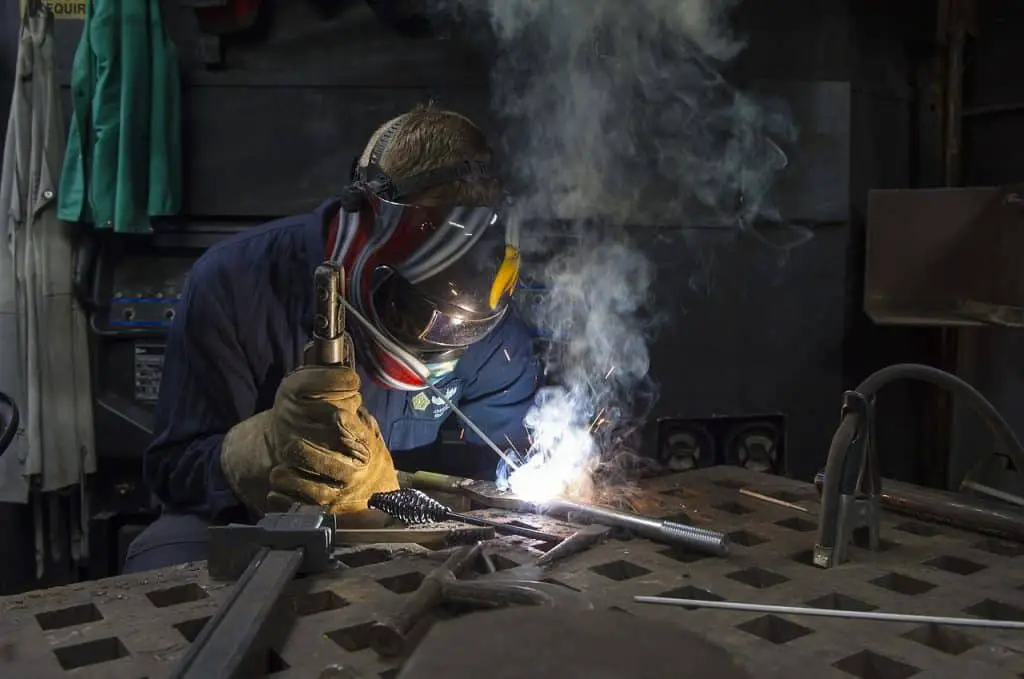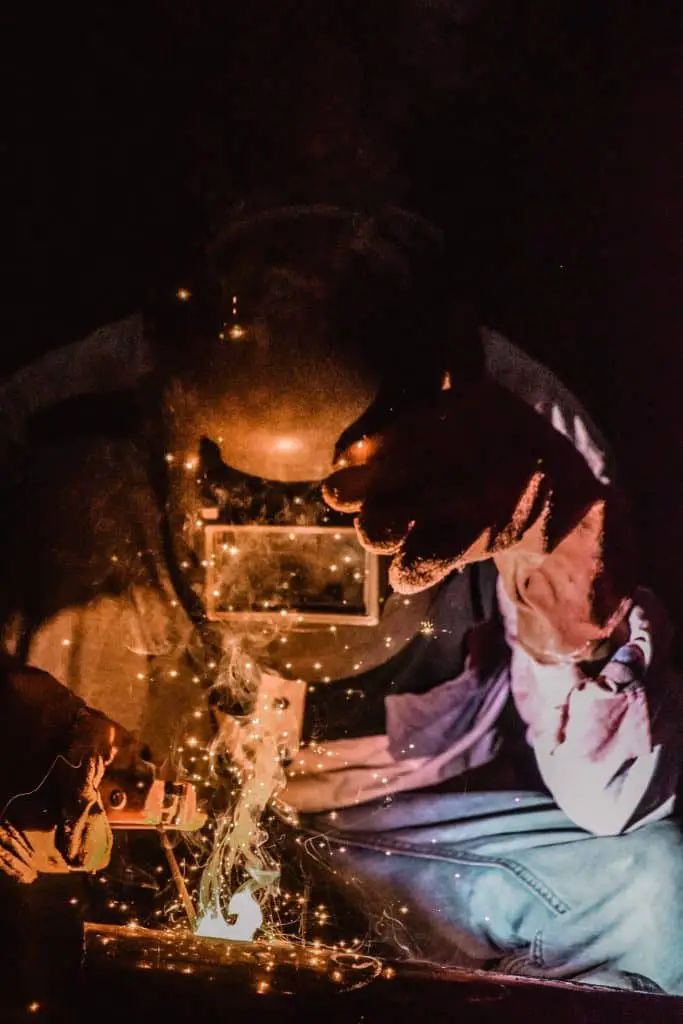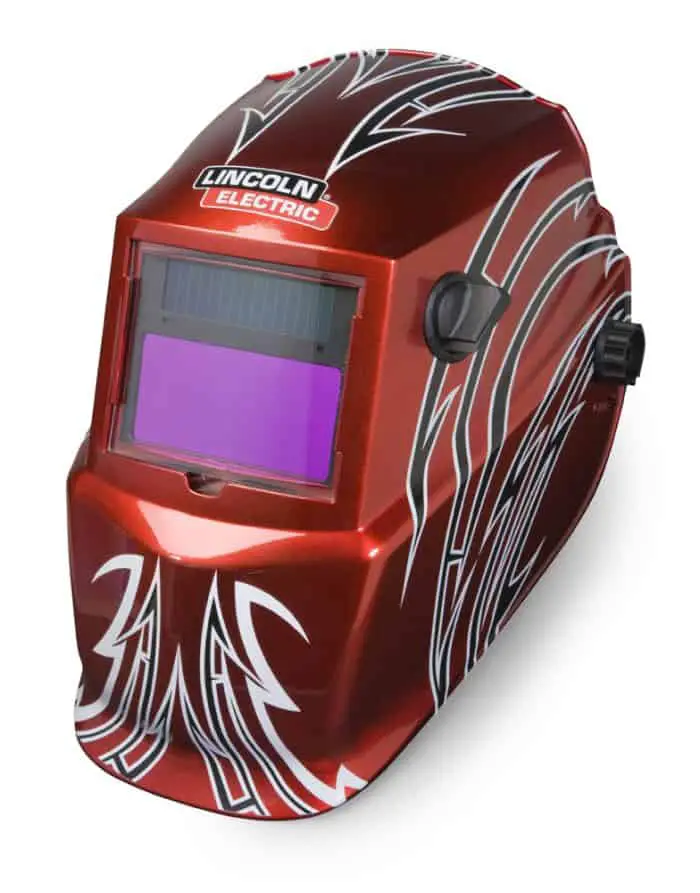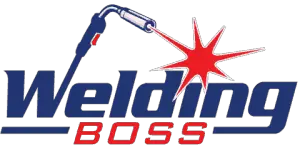This post contains affiliate links to products, services, or education. We may receive a commission for purchases made through links.
When a welder is concentrating on his craft, trying to make the most precise weld he can, he shouldn’t have to worry about whether his safety gear is about to fail. Flashing – a sudden flare of bright light that exceeds his helmet’s protective parameter – is one of those incidents that happen all too often.
Why does a helmet flash, and how do you adjust it? Typically, a helmet flashes when too weak of a protective lens is in place, or on an auto-darkening lens, the shading, delay, or sensitivity is set too low. Therefore, the fix is to switch to a darker lens or make adjustments to the auto-darkening helmet.

While these are the short, quick solutions, there is more to it than that, and it’s far better to begin a welding job with the safety devices – all of them – adjusted and worn correctly so that the issue never comes up in the first place.
So let’s go a little more in-depth into welding helmets – how they evolved, how they work, and how they sometimes don’t.
Standard Welding Helmets
A welding helmet is a welder’s most crucial piece of protective gear. Not only does it protect the welder from sparks and the heat of the molten metal created during the process, but it also protects a welders eyes from damaging light rays.
These light rays, both extremely bright flashes in the visible spectrum and damaging rays from the ultraviolet and infrared regions of the spectrum, can cause severe damage to a welder’s eyes
Standard welding helmets, also known as welding hoods, have not changed much in the past 50 years. The mask is secured to the head via an adjustable harness. The harness fits snugly around the crown of the head.
A shield is attached to this harness in a way that it can be worn up above the face like the visor of a baseball cap, or, with a quick nod of the head, can fall forward to protect the face from sparks during the welding process.
The shield of early welding helmets was made of thick leather, but modern designs are made of molded plastics.

Within the shield of standard welding helmets is a passive darkening lens that protects the welder’s eyes from the light produced when the arc is struck.
The lens is coated in a way that protects the welder from both infrared and ultraviolet rays. The lens is usually tinted to a shade of #10.
If this is not sufficient, you can replace the lens with one tinted to a higher shade (such as #13 or even #14). This standard welding helmet design has been effective for many decades, but there has always been room for improvement.
Auto Darkening Welding Helmets

High-quality auto-darkening welding helmets, on the other hand, come with knobs and switches that control the light sensitivity, delay, and shade of auto-darkening filter.
The benefits of this are that you can leave the shield down in the protective placement position the entire time you are setting up and welding. By properly adjusting the settings of your welding helmet, you can increase your safety and efficiency.
Light Sensitivity
The light sensitivity setting on an auto-darkening filter (ADF) allows you to adjust how bright a light source must be to trigger the darkening of the lens.
This can be useful when welding outside because the sun is an authoritative light source that could trigger your ADF while you are still positioning your gun or torch.
It could also be a factor when working near other welders as their flashes could trigger your ADF as well.
Delay
While the lens always protects against ultraviolet and infrared rays, the darkening of the lens is triggered by the presence of light brighter than the minimum set by the light sensitivity setting.
A quality auto-darkening helmet responds in less than 4/10ths of a millisecond, which is faster than it takes the human eye to perceive.
While you wouldn’t want to slow down this lens response time, you may wish to adjust the time it takes for the darkened lens to undarken so you can see clearly to set up your next weld.
How long you want to set the delay will depend on the welding you’re doing, how sensitive your eyes are to light, and how long the metal glows after the arc is complete.
In general, you want it to last long enough to protect your eyes through the entire flash, but clear up as quickly as possible after so you can set up the next weld.
Shade
The shade setting determines how dark the lens gets. This does not alter the amount of protection from ultraviolet or infrared rays (since the lens constantly protects your eyes from these rays), but instead, the darker the lens gets, the more light it will block out.
Most types of welding require a shading between #9 and #13, though you may want to increase the shade if your eyes are particularly sensitive.
How do I Know if my Auto-Darkening Welding Helmet is Working?
The most common way to check if an auto-darkening welding helmet is working is the sun test. Simply put the helmet on and turn your face toward the sun.
The sun is a powerful light source that should trigger the darkening effect if the helmet is working correctly.
What Shade do You Use For Arc Welding?
When unactivated, an auto-darkening lens usually has a shade of about #3 or #4, which is relatively easy to see through.
When activated during the arc, they should darken to somewhere between #9 and #13, depending on your eyes’ sensitivity and preference.
Do Welding Helmets Have Batteries?
A standard welding helmet has no battery and can last as long as the material isn’t too worn. Masks with a non-replaceable lithium battery usually last about seven years, at which point the entire helmet needs to be replaced.
Helmets with replaceable batteries and/or solar assist are usually a more significant initial investment but can last longer after replacing the battery.
Typically a battery indicator light comes on two or three days before the battery needs replacing.
Solar-Powered and Dual Power Helmets
There are two ways manufacturers power their welding helmets – batteries or solar power. This should not be confused with the operation itself, which is a solar process of a different sort.
A solar-powered helmet is powered by exposure to light, and if it has been stored in a dark cabinet for a long time, it may not have enough stored power to operate.
The easy fix here is to set the helmet out in the sunlight for one to three hours. In some cases, a solar-powered helmet that hasn’t gone entirely dead can gain power while in use because of the exposure to the welding arc.
However, this is a shortcut that shouldn’t be heavily relied upon.
Several manufacturers have developed an auto-darkening helmet that uses solar power and batteries. These are considered cutting edge in the field of welding helmets and could be the norm rather than the exception soon.
How Much is a Good Welding Helmet?
An auto-darkening welding helmet will cost between $250-$400, but the investment is probably worth it if you do a lot of welding.
You’ll appreciate not having to lift the shield between each weld.
Some models even have memory settings, so you can easily switch between settings if you do different types of welding throughout your work.
